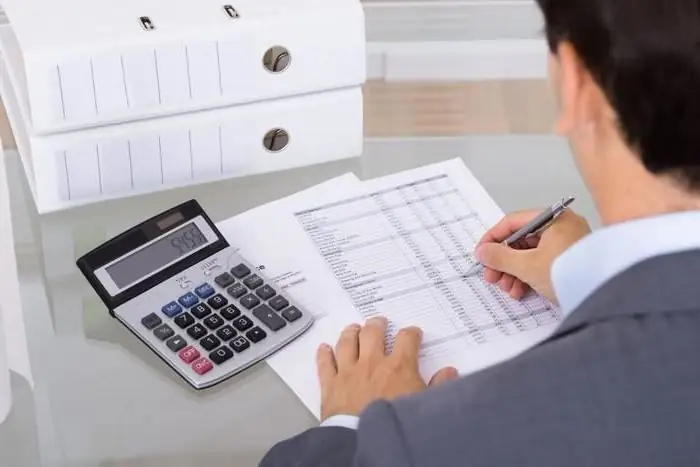2025 Author: Howard Calhoun | [email protected]. Last modified: 2025-06-01 07:12:56
One of the key indicators in the analysis of the financial and economic activities of a trade enterprise is the amount of sales expenses. They are the costs associated with the creation and sale of products. Let's take a look at how sales expenses are accounted for.

Financial accounting: meaning
Today, cost management is one of the main tasks of the enterprise. Its implementation depends mainly on the organization of accounting. This is due to the fact that it is in the reporting that most of the information about the costs necessary to make the right decisions is summarized. One of the key areas in management activities is the accounting and analysis of sales costs. Cost evaluation allows you to determine their feasibility and effectiveness, check the quality of work, plan income, set prices, and so on.
Cost characteristic
Selling costs include costs associated with the sale of products, paid by the supplier, and also involved in educationcost. Let's turn to the law. According to Article 252 of the Tax Code, costs are economically justified indicators expressed in cash and documented. Expenses will be considered any costs if they are made for the conduct of activities, the purpose of which is to make a profit. Depending on the direction of the enterprise, the costs are divided into several categories. In particular, they allocate production, sales and non-operating costs.

Reflection in reporting
To summarize the information, there is a special sales expense account. It can display cost information:
- For the transportation of products.
- Wages.
- Rent.
- Maintenance of structures, premises, buildings, inventory.
- Storage and finalization of products.
- Advertising.
- Representation and other similar services.
All these costs are transferred to account 44. Additional articles may be opened to it. Let's note some of them:
- 44.1 is a sub-account designed to summarize information on commercial expenses that are not directly related to product sales operations.
- 44.2 is an item that is created to collect cost data related to the implementation process. In particular, we are talking about the cost of wages, social benefits, depreciation and so on.
- 44.3 - sub-account, which takes into account the amounts written off to the cost price. This article is required forapplying the partial distribution method.
All these sub-accounts belong to the first level. If necessary, the accountant can open additional articles. Level 2 sub-accounts provide a more detailed reflection of certain types of expenses.

Debit specifics
Account 44 (to debit) transfers the amount of expenses incurred by the enterprise related to the implementation of works, products, services. Their write-off is carried out on D-t account. 90. If it is partial, then in enterprises engaged in trading activities, transportation costs are subject to distribution. All other costs relating to sales are charged each month to cost of goods sold. At enterprises engaged in the procurement and processing of agricultural products, accounting for sales costs includes a summary of information on costs:
- For the maintenance of specialized items, as well as livestock and poultry at the bases.
- General procurement costs.
- Other expenses.
In case of partial write-off, the following are also subject to distribution:
- In enterprises engaged in industrial and other production activities, the cost of transportation and packaging.
- In organizations engaged in the processing / harvesting of agricultural products - to the debit of the account. 15 or 11 (the cost of preparing raw materials and livestock / poultry, respectively).

Nuance
In the instructions for using the chart of accountsit is indicated that at retailers that take into account goods at selling prices, according to K-tu account. 90 show the selling price of the products. Corresponding with it are articles that summarize information about cash and settlements. By debit 90 reflects the book value of goods. Corresponds with him. 41. At the same time, the reversal of the amounts of discounts that relate to sold products is carried out. The offsetting account here is sc. 41.
Cost components
When accounting for sales costs, you must take into account the list of cost elements. In PBU 10/99, as well as in the provision on the composition of costs, the following components are indicated:
- Material costs.
- Payroll expenses.
- Deductions for social needs.
- Depreciation.
- Other expenses.
For management purposes, cost accounting is organized by item. The list of the latter is established by the enterprise independently.

Wages
As some experts believe, when accounting for sales expenses, professionals should pay special attention to payroll costs. This is due to the heterogeneity of these costs. Salary split:
- On views - additional and main.
- Elements - piecework, time, bonuses, downtime reimbursement, and so on.
Besides, the salary depends on the composition of the staff. Employees can work full-time, part-time, under contract agreements. There is also a division into categories: workers, employees.
Cost classification
The division is carried out depending on the method of including costs in the cost price. Direct costs are those that can be attributed to a specific type of product immediately in accordance with the primary documentation. Indirect costs are distributed according to the method chosen by the enterprise. According to Article 318 of the Tax Code, the organization independently classifies the costs. It is advantageous to recognize all costs as indirect. In this case, a one-time write-off of the amount when calculating the tax will be made. When accounting for sales expenses, specialists use their classification for planning and decision-making. It involves a division into relevant (those that are taken into account) and irrelevant. This classification is necessary to determine the selling price, make decisions on increasing the volume of sales, disbanding the market segment.

Fixed and variable costs
This division has a special meaning. It is based on the behavior of costs - the nature of their change depending on the intensity of business activity. Fixed costs in their amount are unchanged. Their rate does not depend on the level of activity. Fixed costs are divided into 3 categories:
- Completely unchanged. They are possible even in the case when the enterprise does not carry out activities. For example, it could be rent.
- Fixed costs to support operations. They are carried outonly during the operation of the enterprise. For example, they include payment for electricity, staff salaries.
- Conditionally fixed costs. They do not change until a certain sales volume is reached. The change occurs if the enterprise begins to purchase new equipment, build workshops, and so on.
Variable costs change in proportion to the intensity of business activity. However, when calculated per unit of product, they will be constant. Direct costs are always variable. When accounting for sales costs, it can be noted that the costs of warehousing products, packaging change with a decrease / increase in sales volume. Accordingly, part of the selling costs can also be classified as variable.

Cost sharing
If the organization records the costs of selling finished products by classifying them as permanent, then at the end of the reporting period they are fully written off to the account. 90. The distribution of costs between types of products, services, works is carried out proportionally:
- Sales volume.
- Costs of goods sold.
- Revenue from sales.
If, while accounting for the costs of selling goods, specialists made a partial write-off, then, as mentioned above, the costs of transportation and packaging are distributed. These costs are directly included in the cost of the respective product categories. If this cannot be done, thencosts can be allocated among certain types of products sold in proportion to cost, volume or revenue.
Transport costs
Transportation services provided by an intermediary are assigned to sub-account 44.2. At the end of the reporting period, the article is closed. In case of incomplete sale of products, transport costs are partially written off. To determine the amount, you need to identify the amount of costs for residual products. This is done like this:
- The amount of transportation costs is calculated, which falls on the balance of goods at the beginning and end of the period (R tr. current + R tr. n.).
- The indicator of sold and residual products in the reporting month is determined.
- The average percentage of transportation costs to the total cost of goods is calculated - the ratio of the first indicator to the second.
- The amount of the balance of products at the end of the month is multiplied by %.
- The amount to be written off is determined.
The above items can be combined into a formula:
Rtr. k \u003d Sktov x ((Rtr. current + Rtr. n.): (Sktov + Obkp)), in which:
- end balance 41 (price of unsold items) - Sktov;
- current transportation costs in the reporting period - Rtr. current;
- the amount of transportation costs attributable to the balance of products at the beginning of the month - Rtr. n.;
- turnovers on K-tu account. 90 (Volume of products sold) - Obkp.
The remaining costs are transferred to Dt c. 90. The costs of transport services provided by intermediaries, which account for unsold products, remain at 44thaccount. They are carried over to the next period.
Extra
To ensure effective management, according to some experts, it is advisable to keep records of the cost of selling products by responsibility centers. This will allow the organization to transform the entire reporting system so that revenues and costs are accumulated and reflected in the documentation at certain levels. In other words, each business unit will only be burdened with the costs and revenues that it controls and is responsible for.
Recommended:
91 account - "Other income and expenses". Account 91: postings

Analysis of the profit or loss received by the enterprise based on the results of the reporting period should be based on the structure of this indicator. This will provide an opportunity for further planning of expenses and stabilization of income values
44 Accounting Account "Sales Expenses"

In accounting, there is an account 44 ("Costs of sale"), showing the costs incurred by the organization, which are associated with the sale of goods, services, works, products. How to make account transactions? Let's look at a few examples
44 accounting account is Analytical accounting for account 44

44 accounting account is an article designed to summarize information about the costs arising from the sale of goods, services, works. In the plan, it is, in fact, called "Sales Expenses"
Active sales - what is it? Nikolay Rysev, "Active sales". Active sales technology

In the business environment, there is an opinion that the locomotive of any business is the seller. In the United States and other developed capitalist countries, the profession of "salesperson" is considered one of the most prestigious. What are the features of working in the field of active sales?
A settlement account is Opening a settlement account. IP account. Closing a current account

Settlement account - what is it? Why is it needed? How to get a savings bank account? What documents need to be submitted to the bank? What are the features of opening, servicing and closing accounts for individual entrepreneurs and LLCs? How to decrypt bank account number?

